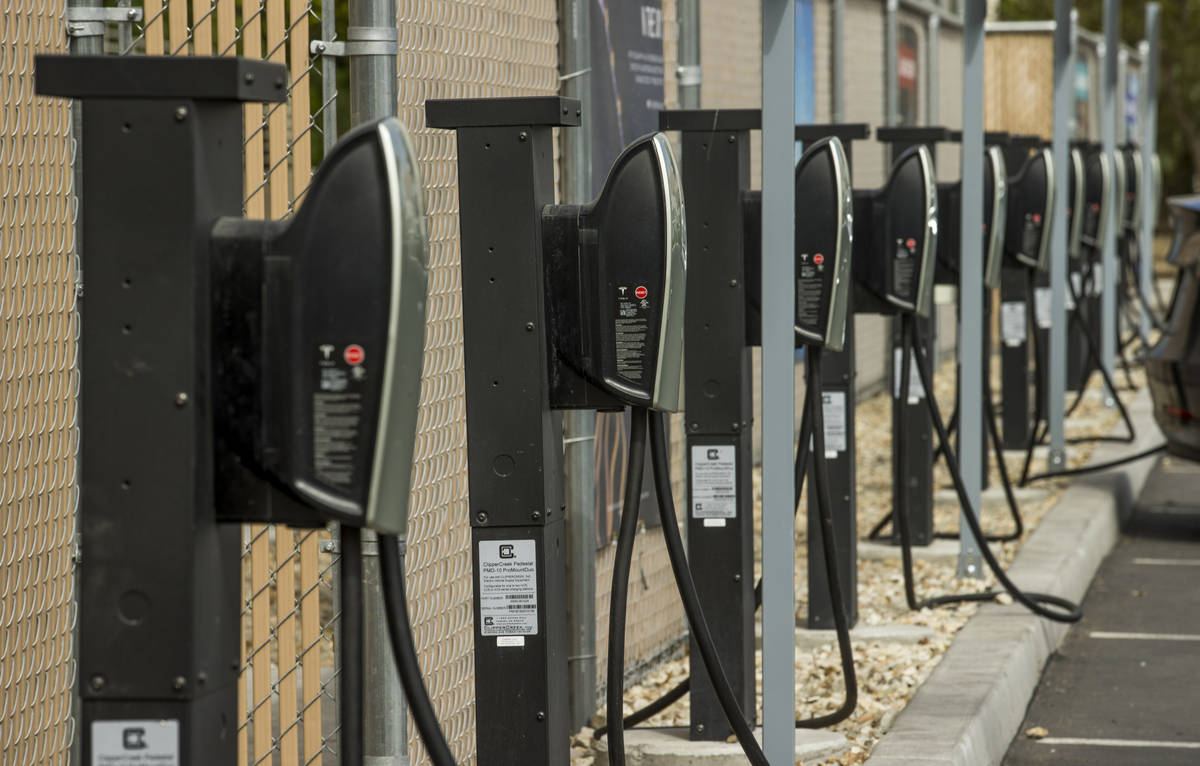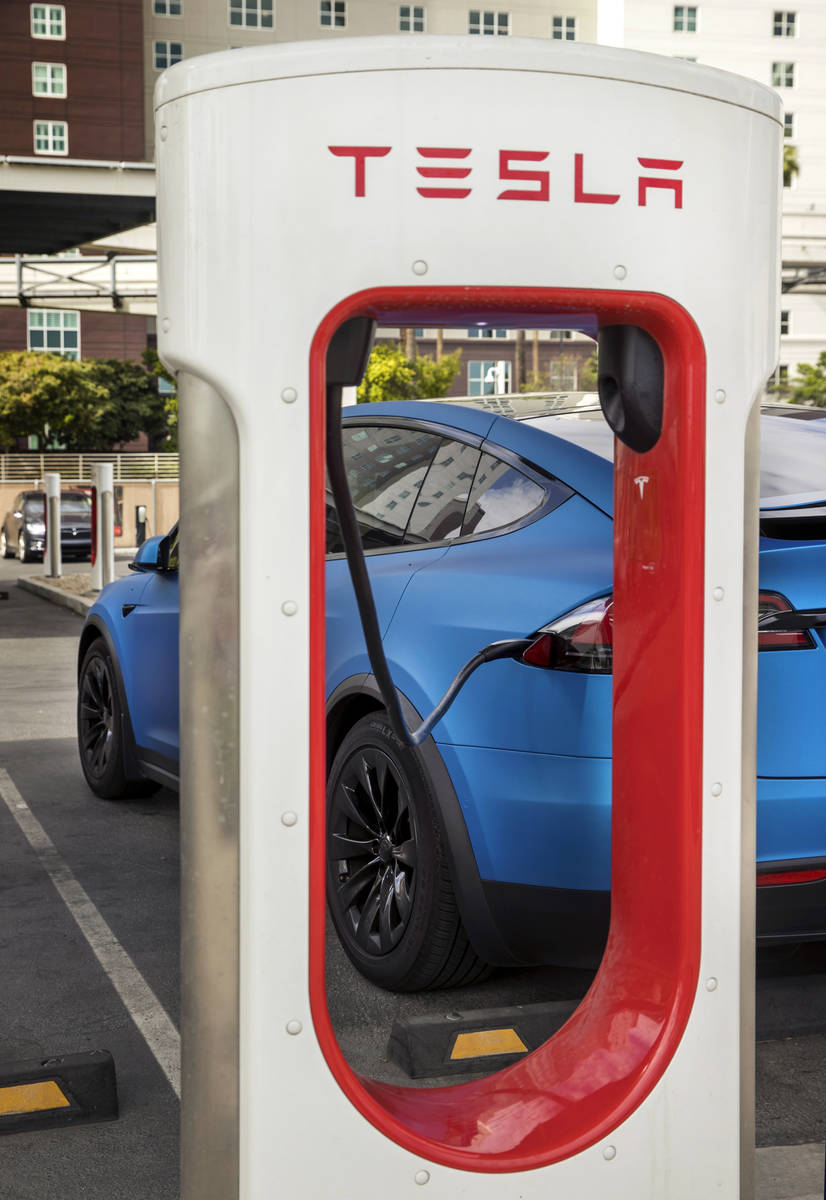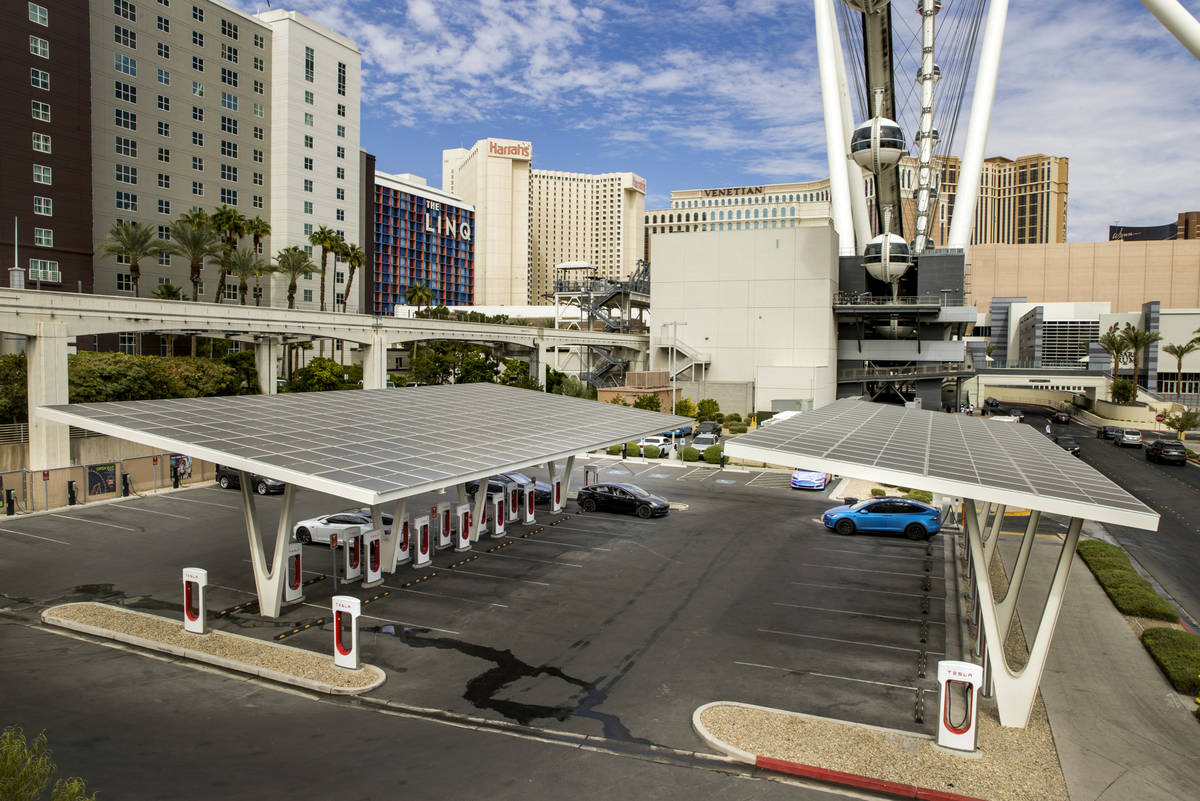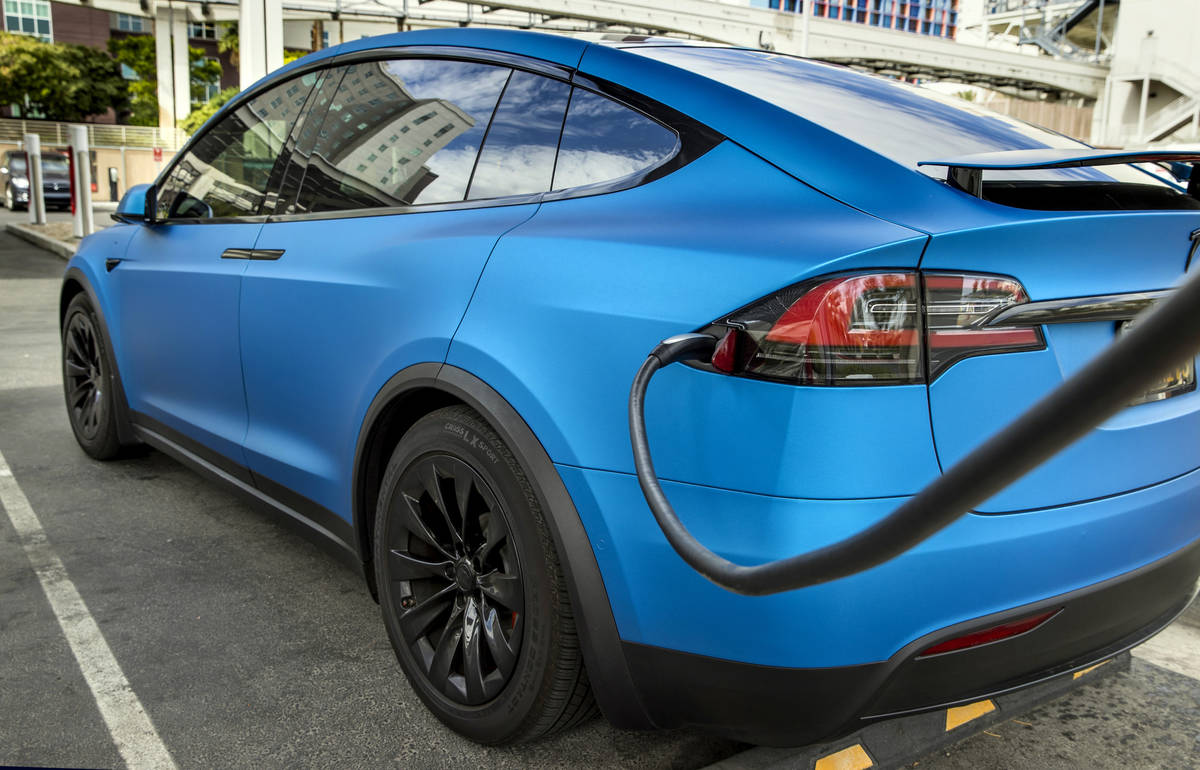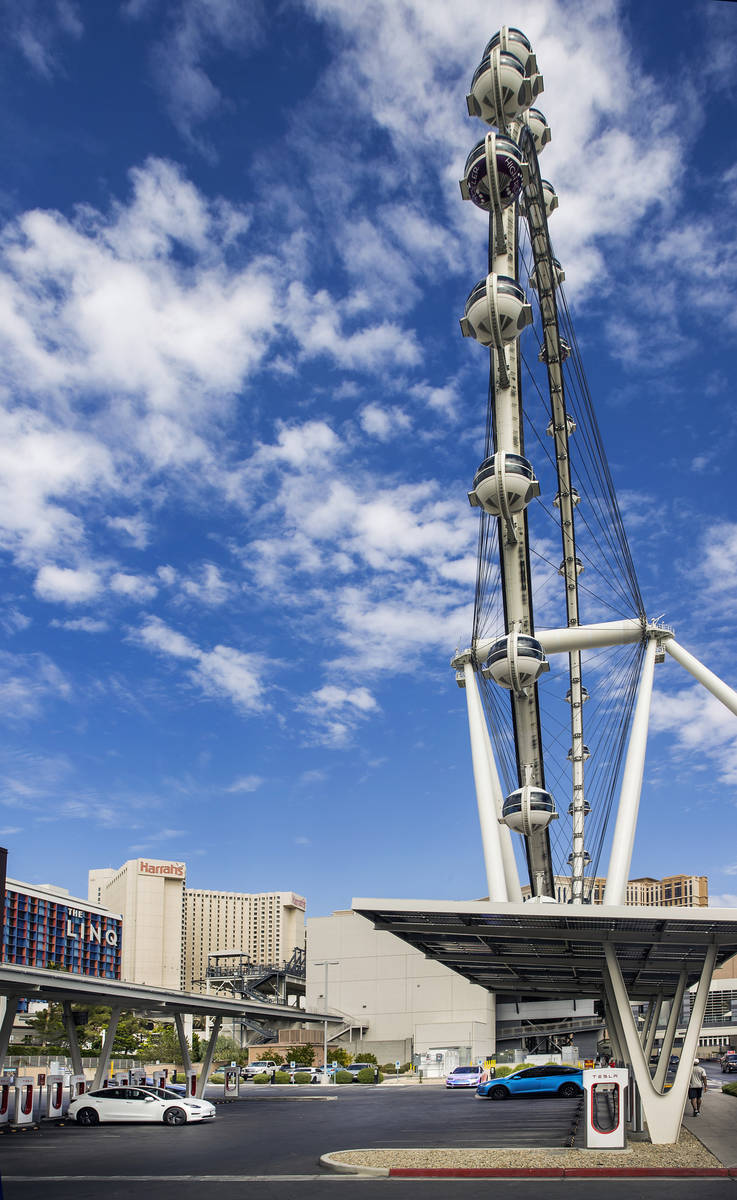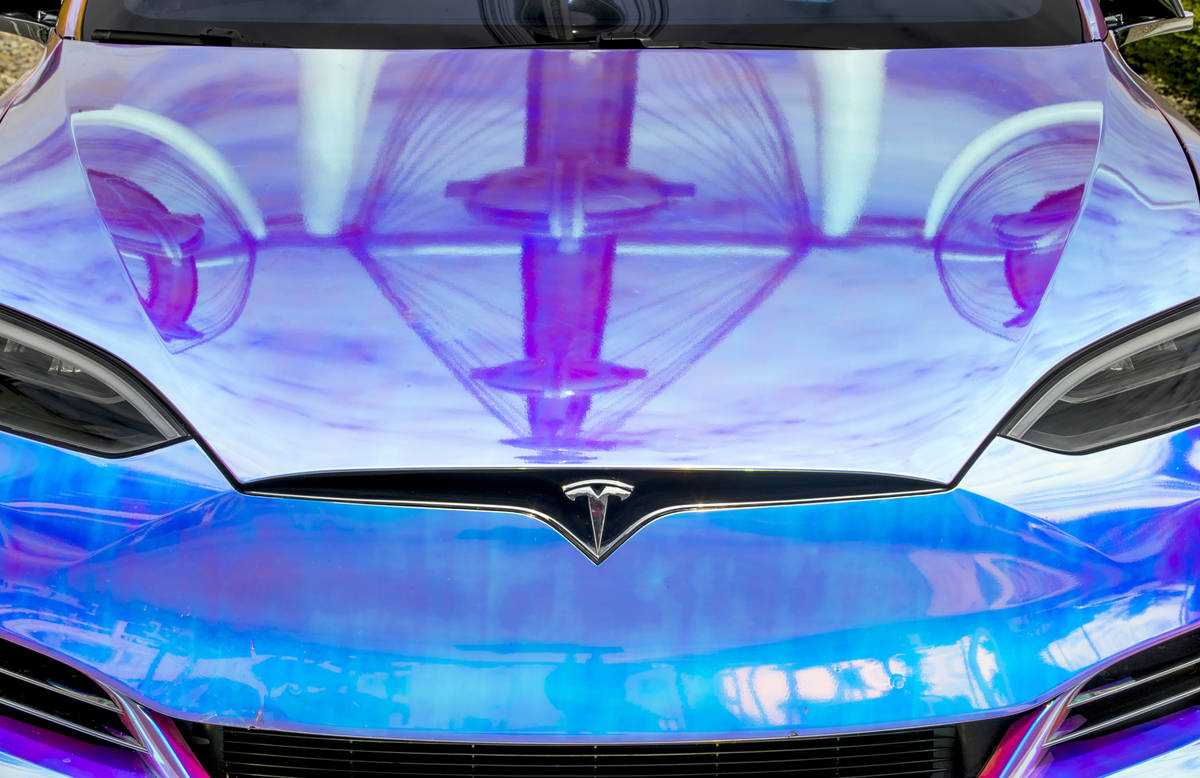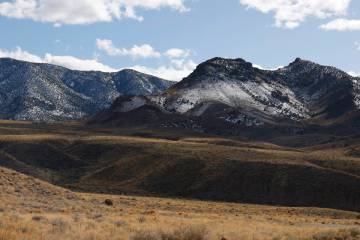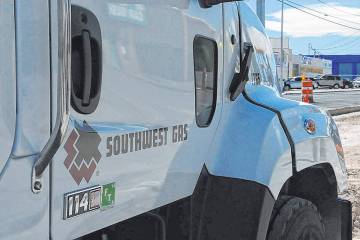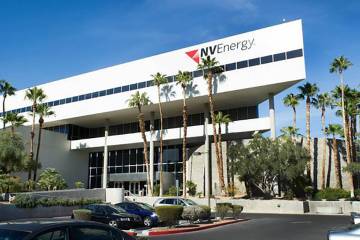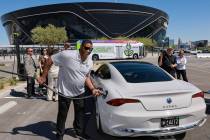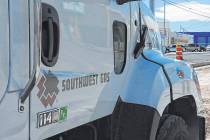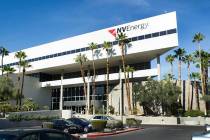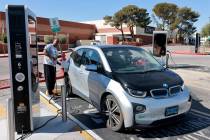Las Vegas braces for electric tourism boom with California’s gas car sales ban
A power source for Nevada’s tourism industry plans to switch its fuel from pump to socket.
Experts say California’s phasing out of gas-powered vehicles is a move with future potential, but Nevada and its resort corridor have some work to do to ensure that an influx of Golden State electric cars juices, rather than short-circuits, the Silver State’s tourism industry.
California Gov. Gavin Newsom signed an executive order last month that will require all new cars sold by 2035 to be electric or produce zero emissions.
The move means Nevada must have electric vehicle charging infrastructure in place to accommodate one of its key visitor hubs, including at its Strip hotel-casinos, and it means another potential strain on the power grid during hot summer months.
Last year, an average of 44,658 vehicles crossed the California border with Nevada on Interstate 15 each day, and about 18 percent of all visitors to Las Vegas came from Southern California, according to Las Vegas Visitors and Convention Authority data.
Electric highway
If Southern Californians want to make the trip to the Strip, their cars have to be capable of, well, making the trip.
The knock on electric vehicles when they first came out was they could not go all that far, according to Stan Hanel with the Las Vegas Electric Vehicle Association. That’s changing with newer models, particularly Teslas, that can travel “at-minimum 300 miles between charges,” he said.
The drive on I-15 from Los Angeles to Las Vegas is just under 300 miles, and ample charging options along the way in Victorville, Barstow and Baker make it a “certainly feasible” trip for electric car drivers, according to Raquel Soat of Guidehouse Insights.
“The EV technologies and range that could achieve a trip from Los Angeles to Las Vegas will be mainstream by 2035,” she said.
Nevada already has charging stations along its own stretches of the interstate thanks to the Nevada Electric Highway project, which began under then-Gov. Brian Sandoval. The project aims to install electric charging stations every 50 miles along Nevada’s highways.
The state’s Department of Energy completed station installations along Interstate 15 this year, director David Bobzien said.
The publicly available charging stations include “Level 2” and DC fast charging, the latter of which may be capable of providing a near-full charge in 30 minutes.
“That’s a huge feather in our cap and an obvious welcome mat to the California market when it comes to tourism,” he said.
Additionally, the state electrified U.S. Highway 95 and is “in the homestretch now,” Bobzien said. The energy department hopes to complete or begin progress on its remaining projects on Interstate 80 and U.S. highways 50 and 93, he said.
Infrastructure
Nevada will need more power and plug-ins for its future wave of electric guests.
As it stands, Las Vegas boasts “an incredible amount of charging infrastructure already on the Strip and at the casinos,” NV Energy Electrification Director Marie Steele said.
Several Strip hotel-casinos already offer some charging stations to guests. MGM Resorts International has charging ports at Aria, Bellagio, Mandalay Bay, Luxor, The Mirage, New York-New York and Park MGM, according to user-driven station locator PlugShare.
“We have for several years offered eco-minded guests sustainable options, including electric car charging stations at many of our properties in Las Vegas and regionally,” MGM spokeswoman Callie Driehorst said in a written statement. “As we progress towards our goal to reduce carbon emissions by 50 percent over the next five years, we refresh our approach to adjust for new changes in guest demand or regulatory changes.”
Caesars Entertainment has electric charging stations at multiple properties and will continue to add more “as demand for electric vehicle charging increases,” said Eric Dominguez, the company’s senior vice president of engineering and asset management. Its latest charging site, behind the The Linq Promenade, was completed last year and hosts 39 charging stations.
“We want to make it easy for our guests to switch to cleaner forms of transportation,” Dominguez said.
Representatives for Las Vegas Sands Corp., Boyd Gaming Inc., Station Casinos didn’t return requests for comment. A Wynn Resorts Ltd. spokesman declined to comment.
Still, Steele said, Las Vegas will “definitely” need more charging stations in the coming years if it is to handle the potentially thousands of hotel guests who will need a spot to re-energize their battery.
Then there’s the matter of producing enough power to handle the coming fleet. Steele said NV Energy is working on it, developing short-term and long-term plans to integrate electric vehicle “load” on its system. She called increased power needs “a good thing” as the state transitions to renewable energy in accordance with its zero-carbon-by-2050 target.
“Electric vehicle tourism is something that we’ve obviously been keeping our eye on for a long time, and it’s just growing,” she said.
How those infrastructure changes integrate into the power grid will be “critical” as more electric vehicles hit the roads, she added.
Power grid
Just because you flip the light switch in Las Vegas doesn’t mean that power was produced in Nevada.
NV Energy shares the same power grid with California and other Western states. They buy and sell power from one another to keep on everybody’s lights.
This sharing agreement means increased power usage in multiple states — such as thousands of electric cars simultaneously charging — affects the whole grid. It’s another piece of the puzzle, especially when factoring the summer months when air conditioning units are on full blast across the West.
“There’s ways to mitigate it already, but we’ll certainly have to plan for it going forward as well,” she said.
Smart stations at casinos could charge guest vehicles at off-peak times, and new stations across the valley will probably include their own storage to ease the amount of power being used across the power grid at one time, Steele said. Time-of-use tariffs implemented in 2007 also incentivize charging at off-peak usage times.
As renewable energy grows, finding ways to funnel electric vehicle usage through excess renewable supply could prove beneficial. Additionally, she said, there’s “nascent” technology being piloted that allows electric vehicle batteries to power someone’s home.
“I think we’re taking the right steps right now to be ready,” she said.
Bobzien, the state’s energy department director, noted that the electric vehicles-as-moving-batteries could reduce overall strain on the power grid, as do developments in renewable energy storage. Additionally, he said, a regional transmission organization for the West similar to those in the mid-Atlantic and Midwest could more efficiently distribute power among the states as needed.
‘That’s tomorrow’
Still, there are other considerations regarding California’s transition plan and potential larger effects.
Nevada and its leaders must be proactive in preparing for a growing electric tourism industry, because “in my opinion, we are not prepared,” said Tom Skancke, who previously served four years on the Nevada Department of Transportation Board of Directors. Skancke said the Nevada Legislature in the 2021 session must make it easier for NV Energy to produce more power and handle the incoming demand.
California’s phasing out of gas vehicles, while “well-intentioned on the surface,” creates a new problem of a steep decline in fuel tax funding that pays for state and national highways, Skancke said.
“(The year) 2035 is not that far out,” he said. “That’s 15 years. That’s tomorrow.”
Bobzien said Nevada lawmakers were aware of the fuel tax issue and are examining ways to modernize highway funding. In the meantime, he said, Nevada leaders see opportunity for economic growth, tourism and combating climate change through electric vehicles and the state’s membership in the Rev West alliance. The alliance comprises of governors from eight Western states and is committed to working together to make their states more electric-vehicle friendly.
“It’s a huge opportunity for Nevada, and it’s one that we’re already well positioned to take advantage of,” he said, “but (it) will certainly require some concerted effort in the years to come on the part of policymakers, the private sector and others to fully take advantage of.”
The Review-Journal is owned by the family of Las Vegas Sands Corp. Chairman and CEO Sheldon Adelson.
Contact Mike Shoro at mshoro@reviewjournal.com or 702-387-5290. Follow @mike_shoro on Twitter.





